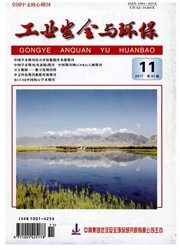

 中文摘要:
中文摘要:
生物降解方法是处理有机物污染的土壤和地下水的主要途径。试验以污染场地土壤为样本,分析土样的有机碳含量、容重、密度、孔隙比、饱和含水率等基本物理特性,并制作成试验土柱,模拟研究四氯化碳在包气带土壤中垂直迁移规律,动态分析影响生物降解的主要因素。结果表明,四氯化碳随淋溶作用向深层迁移,并在包气带底部积聚;温度是影响生物降解的重要因素,当温度为18℃时,稳定降解率最大为48.2μg/L;该菌株最适宜降解的四氯化碳淋溶强度为42.3μg/L,此时菌株能正常地进行生物代谢;25 g/L的葡萄糖对微生物降解有促进作用,稳定降解率达44.3%。
 英文摘要:
英文摘要:
Biodegradation is the main way to disintegrate organic pollutants in soil and groundwater. Soil samples of contaminated sites are used to analyze its physical properties of organic carbon content,bulk density,density,void ratio and saturation moisture contents and also they are made into experimental soil column,which is applied to simulate the vertical migration patterns of carbon tetrachloride( CT) in unsaturated zone and its dynamic biodegradation.The results show that carbon tetrachloride migrates with eluviation and accumulates in the bottom of the unsaturated zone. Temperature is the important factor affecting biodegradation and when temperature is 18 ℃,the maximum degradation rate is 48. 2 μg / L under steady state. For this strain,the most suitable degraded concentration of carbon tetrachloride is 42. 3 μg / L and at this time,this strain can normally conduct biological metabolism. Meanwhile glucose with concentration 25 g / L can promote microbial degradation and the degradation rate can reach 44. 3% under steady state.
 同期刊论文项目
同期刊论文项目
 同项目期刊论文
同项目期刊论文
 期刊信息
期刊信息
